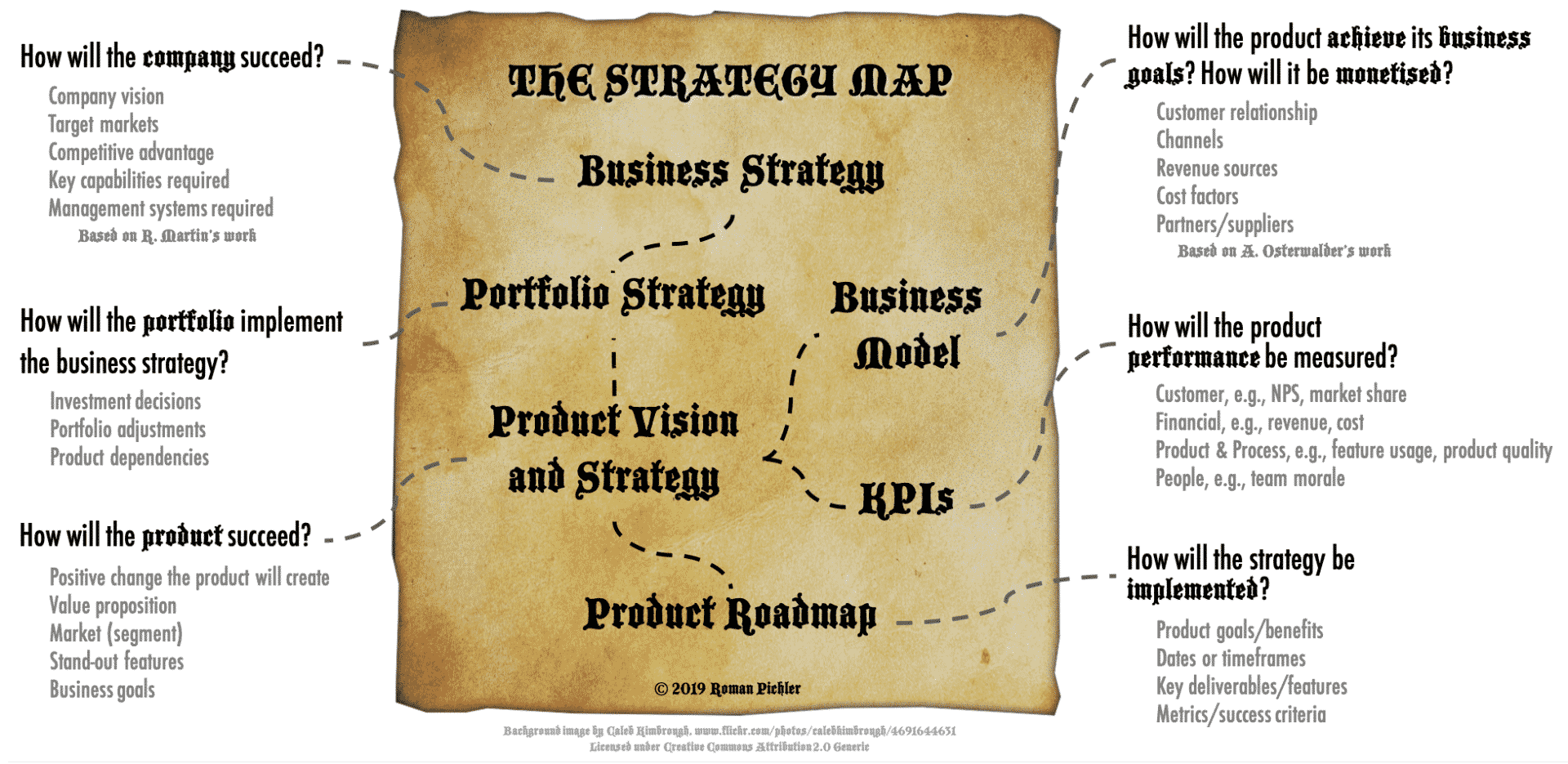
Maps are the Foundations on which Adventures are Built
When I was a little boy, I truly loved all things pirate. Even as an adult, I very much enjoyed reading pirate books with my children. One of them even came with a separate treasure map that could be unfolded to discover a hidden treasure. Coming up with a set of tools to capture important strategic decisions reminded me of treasure maps: It should guide you to product success, bearing in mind that not all treasure is silver and gold, as Captain Jack Sparrow put it.
 The map below shows the strategy tools I find helpful to make effective product strategy decisions. Please click on the image to enlarge it.As the Strategy Map above shows, you should be aware of the overall business and product portfolio strategy in order to make the right strategic product decisions, as these provide the necessary context. To put it differently, if you don’t know the business and portfolio strategy, or if these plans don’t exist, then it will be hard for you to get the product strategy right and choose, for example, the right market and target group.
The map below shows the strategy tools I find helpful to make effective product strategy decisions. Please click on the image to enlarge it.As the Strategy Map above shows, you should be aware of the overall business and product portfolio strategy in order to make the right strategic product decisions, as these provide the necessary context. To put it differently, if you don’t know the business and portfolio strategy, or if these plans don’t exist, then it will be hard for you to get the product strategy right and choose, for example, the right market and target group.
Additionally, you should be able to correctly state the information captured by the product vision and strategy, product roadmap, KPIs, and business model on the map above. Please note that you should derive the KPIs from the value proposition and business goals so that they help you understand how much value the product is creating for the users and the business.
The Strategy Map can help you check if you have any strategy blind spots. I find that some product people forget about the business strategy and the business model; others aren’t aware of the portfolio strategy, for instance. If that’s the case for you, then explore what it would take to fill the gaps and acquire the relevant information. This might simply involve talking to the right people like the head of product or the CEO. But it might also mean carrying out discovery work, for example, when you lack a validated product strategy or an effective business model.
Tools of the Trade
Navigating the seas and reaching a treasure island was no easy feat for pirates who had to rely on tools like compass, sextants, and nautical charts. Once on the island, the treasure map, a compass, and digging tools would be crucial to find and unearth the treasure. Similarly, there are a number of specific tools and templates that can be helpful to capture the information shown on the Strategy Map above. Here are my favourites:
- Roger Martin’s business strategy approach for business strategy decisions;
- Product Portfolio Matrix and Innovation-Ambition Matrix for making portfolio decisions;
- Product Vision Board to capture product vision and strategy;
- GO Product Roadmap to describe the product roadmap;
- Alexander Osterwalder’s Business Model Canvas to state the business model as a stand-alone artefact to complement the product strategy or the Extended Product Vision Board to capture the relevant business model elements together with the product strategy and vision.
- Balanced Product Scorecard for the KPIs (possibly using Dave McClure’s pirate metrics).
Please note, though, that product strategy is not about filling out templates and ticking boxes—but asking the right questions and being able to correctly answer them. Carrying out strategy work really is like going on an adventure: You have to be curious and receptive, cultivate a playful mindset, and be willing to discover and learn new things. Therefore choose the templates and tools that resonate most with you and that are helpful in your specific context.
The Map is Not the Territory
While I hope that you find the Strategy Map above helpful, don’t make the mistake to blindly follow it. Instead, consider if you should adjust it or create your own map for your very own product adventure. For example, you don’t need a portfolio strategy if your business only has one product, which is typically the case for early-stage start-ups. Similarly, you may disagree with my product-centric take on the business model and want to link it to the business strategy, which is totally fine. And if you work for a portfolio company like GE or Siemens that is essentially a holding of several independent or loosely coupled businesses, you may find that you need to add a corporate-level strategy that sits above the business strategy, as the latter will be focused on your individual business or business group.
Additionally, consider reflecting on your notion of what a (digital) product is before applying the Strategy Map. I find it not uncommon that people confuse the concepts product, feature, component, and sometimes even portfolio, which can result in too many detailed product strategies and roadmaps. I like to define a product as an entity that creates a specific value to a group of people while at the same time, helps the business achieve one or more goals. A feature is a product part users can interact with like search and navigation on an online retailer’s website; a component is an architecture building block such as the data access layer; and a portfolio is a group of (related) products—think of Microsoft Office, for example. A product strategy should hence always describe your approach for making or keeping a product successful. Don’t create a strategy for a feature or component—unless you decide to unbundle it and release it as a separate product.
And now to work: Adventure awaits. Aarrr!
The post A Strategy Map appeared first on Roman Pichler.
A Strategy Map posted first on premiumwarezstore.blogspot.com

No comments:
Post a Comment